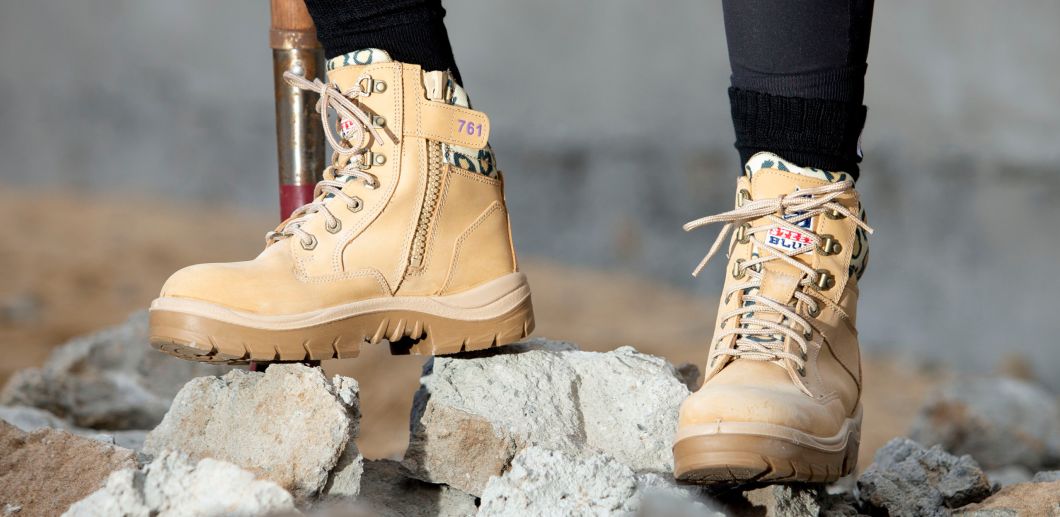 Did you know that the way you lace up your boots can make a big difference to how comfortable they are to wear?
Did you know that the way you lace up your boots can make a big difference to how comfortable they are to wear?
Through lacing, you can alter the pressure distribution within the foot, delivering a more secure, comfortable, and supportive fit.
Choosing the right lacing method for your feet can also help reduce strain, injuries and avoid common issues, such as blisters.
How you lace your boot matters
Our feet do a lot more than just help us get from A to B. With every step, they’re absorbing twice our body weight in downward force. That means any issues with our feet can cause problems throughout our whole body, putting it out of alignment, and causing pain and discomfort.
That’s why it’s so important to have fit-for-purpose, supportive, comfortable boots.
But why does lacing matter?
Well, by changing the way you lace up your work boots you can improve the fit, support and function of the boot, reduce any pain you feel, and decrease your risk of injury.
But surely all boots are laced up more or less the same way?
You might not have given much thought to the way you lace up your boots. Perhaps you didn’t know there were different ways to lace, or that changing your lacing can tighten or loosen a fit for optimal comfort or safety.
The truth is lacing can make a huge difference to your experience of wearing your work boots.
The Australian Physiotherapy Association says that any abnormal loading or undesirable movement of the feet can lead to increases or misbalances of pressure in the foot. Studies show that foot biomechanics can have a huge impact on the joints of the spine and lower limbs, including the ankles, knees, hips and lower back.
Footwear, including work boots, can play a significant role in the loading and movement in those joints while walking or standing. This becomes particularly important if you have feet that are difficult to fit.
Do I have feet that are difficult to fit for work boots?
Feet that can be difficult to fit include those with narrow heels, a wide forefoot, or high or low arches.
- Narrow heel: Your heel is narrower than the average compared to your forefoot (the front part of your foot). If the heel of your shoe often feels loose or your heel feels unsupported in a shoe or boot, this could be you.
- Wide forefoot: The front part of your foot (the ball and the toes) is wider than the average foot. If your forefoot or toes often feel squeezed in a shoe or boot, this could be you.
- High arches: The arch (or instep) of the foot is the raised part between the ball and the heel. If you imagine a typical footprint (for example, from wet feet on a floor) you’ll see the ball and the heel joined in a bean shaped print. If you have a high arch, the print left by the heel and the ball will be separate/won’t join together.
- Low arches: These are sometimes called flat feet or fallen arches. It means the instep arch is either low or missing completely (that is, nearly all or all of the bottom surface of the foot connects to the ground, so your footprint looks like an entire foot). This is really common, but it can mean that your feet roll in when you walk.
If any of these situations sound like you, the good news is that changing the way you lace up your work boots can do a lot to accommodate the specific requirements of your feet. Through lacing, you can alter the pressure distribution within the foot, delivering a more secure, comfortable, and supportive fit.
What is a correctly fitted work boot?
In addition to looking at the right way to lace your boots, let’s quickly run through some advice that’s important to ensure every boot fits correctly:
- Lace your boots all the way to the top, every time
- Check your laces and boots fit properly, every time you put them on
- If something changes, making your footwear feel uncomfortable, consider changing the way your boots are laced, to improve your comfort and the performance of the boot
- If possible, tie your laces securely with a double knot, so they don’t come undone at work.
So how should I lace up my boot?
There's a lot of different ways to lace up your boots, but this visual guide from Steel Blue goes over some of the best methods for pretty much any style of boot.
For further information, check out Steel Blue's post on How to Lace Your Boots here





